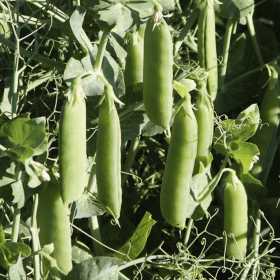How to Grow Peas – A Guide to Growing Peas
 Peas
Peas
One of the oldest known vegetables, humans have been eating peas for thousands of years. Freshly picked peas are incredibly sweet – but eat them quickly, the natural sweetness converts to starch quite quickly after they’ve been picked. They are closely sown so are good grown in containers.
Sowing and Growing Peas
- Sow seeds in late-February to June. Later sowings often suffer with powdery mildew, so choose a variety with resistance to it.
- Peas have nodules in their roots which enable them to produce their own nitrogen. They like a well drained soil, with a plenty of humus but do not need manure to be added before planting.
- For the earliest crop, cover the planting area with cloches a week before planting. Sow direct in late February–early March. Early sowings often avoid the Pea Moth that makes such a mess with tiny caterpillars eating the peas in the pods.
- Sow peas in a trench 15 cm (6 in) wide and 3–5 cm (2 in) deep. Place the peas into the trench 8 cm (3 in) apart in staggered rows. For further rows leave a space of the same size as the height of the variety you are growing. Taller varieties will therefore be much further apart than the dwarf varieties
- Smaller areas can be sown in a block, 8 cm (3 in) apart each way. Some dwarf varieties will be self-supporting and will not need staking when grown in this way.
- They can also be sown directly into deep containers of multi-purpose compost in March and then in succession through to June. When the pods begin to form, feed with a liquid tomato feed.
- Support dwarf varieties with pea sticks or twigs inserted into the trench, or container, at the time of sowing. This support gives the peas something to climb and keeps the pods off the soil.
- Tall varieties can be supported on netting, or twine, attached to firm stakes inserted at intervals of 90 cm (36 in) or less, adjacent to the row. Make sure that the structure is firmly fixed, or a windy day can wreck the crop!
- If your soil is healthy, feeding is not generally required, but a feed of liquid comfrey fertilizer will be helpful as the pods form.
Harvesting Peas
- Harvest May to August, as pods fill up.
- Peas develop upwards on the plant, so start to harvest from the bottom.
- Pick regularly as leaving pods on the plant will stop new ones from forming.
Pests and Problems with Peas
- Birds and mice target newly sown peas. Sowing under cloches, or netting, will keep the birds off. Laying spiky gorse clippings, or holly leaves, on the seeds before drawing over the soil is a suggested preventative against mice.
- The pea moth is attracted to peas that are in flower, laying their eggs on them. When they hatch they find their way to the pea pods and grow into caterpillars in there, eating the peas. If the moth is a problem in your area, protect the plants with fleece, or enviromesh. The pea moth is active mid-May to mid-June, so an early or late sowing is advisable.
Varieties of Pea
There are many varieties of peas, but they fall into the following groups.
- Round varieties (smooth when dried) are hardier than wrinkled varieties. They are all dwarf varieties and ideal for the earliest sowings. Some varieties can be sown October–November but failure rates are high and peas sown in early spring, under protection, will catch up.
- Marrow fat peas (wrinkled when dried) produce heavier crops but are as not as hardy as the round varieties. They are further sub-divided by their height and the time in which they develop: dwarf (45–60 cm/24 in); tall (up to 2 m/6½ feet); first earlies (11 weeks from sowing to harvest); second earlies (13–14 weeks); maincrop (15–16 weeks to harvest)
- As the whole pod of Mangetout, Chinese peas, snap peas or sugar peas, is eaten -they need to be picked young.
- Petits pois are specially bred to produce small and very sweet peas.
- The best varieties for container growing are the earlies, as they crop in the shortest time. The variety Half Pint has been bred specifically for containers and is small enough to grow in a cold frame for early crops.
Eating
- Peas are a good source of fibre and contain useful amounts of riboflavin, magnesium, phosphorus, potassium, thiamine, iron and manganese, vitamins B6, A, C, and K.
- Raw peas contain four times more vitamin C than cooked peas – try adding fresh raw peas to a salad.
- Freeze any glut of peas, as soon as possible after picking, or they can be dried at home.



